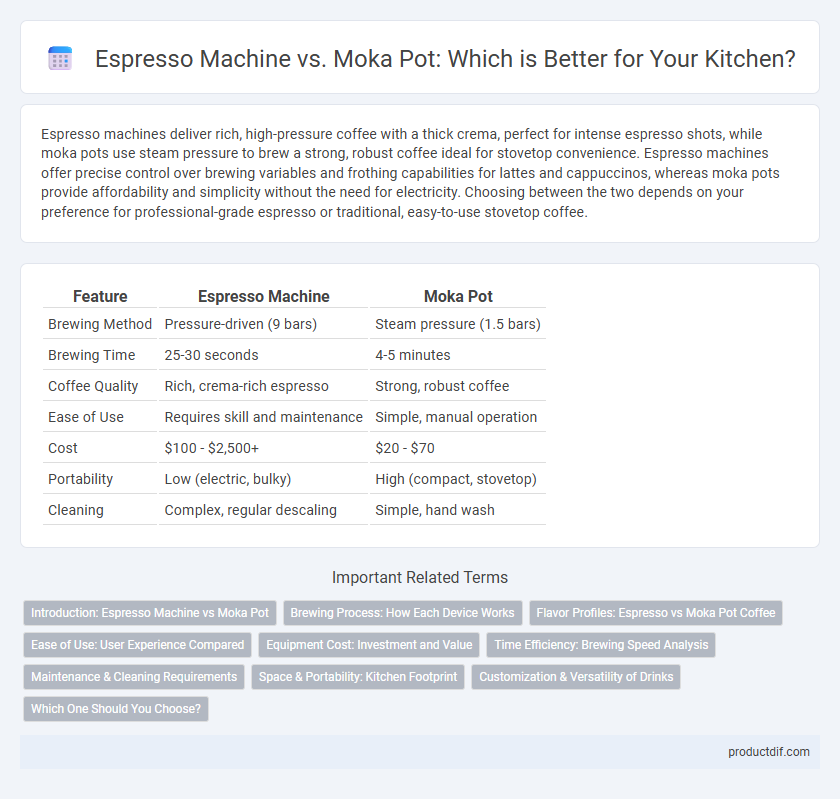Espresso machines deliver rich, high-pressure coffee with a thick crema, perfect for intense espresso shots, while moka pots use steam pressure to brew a strong, robust coffee ideal for stovetop convenience. Espresso machines offer precise control over brewing variables and frothing capabilities for lattes and cappuccinos, whereas moka pots provide affordability and simplicity without the need for electricity. Choosing between the two depends on your preference for professional-grade espresso or traditional, easy-to-use stovetop coffee.
Table of Comparison
| Feature | Espresso Machine | Moka Pot |
|---|---|---|
| Brewing Method | Pressure-driven (9 bars) | Steam pressure (1.5 bars) |
| Brewing Time | 25-30 seconds | 4-5 minutes |
| Coffee Quality | Rich, crema-rich espresso | Strong, robust coffee |
| Ease of Use | Requires skill and maintenance | Simple, manual operation |
| Cost | $100 - $2,500+ | $20 - $70 |
| Portability | Low (electric, bulky) | High (compact, stovetop) |
| Cleaning | Complex, regular descaling | Simple, hand wash |
Introduction: Espresso Machine vs Moka Pot
Espresso machines deliver high-pressure extraction, producing rich, crema-topped coffee ideal for authentic espresso lovers, while moka pots use steam pressure to brew a strong, stovetop coffee with robust flavor. Espresso machines offer customizable settings and faster brewing cycles, making them suitable for precise, professional-quality espresso. Moka pots provide an affordable, compact alternative, favored for their simplicity and durability in home kitchens.
Brewing Process: How Each Device Works
Espresso machines use high-pressure steam or water at around 9 bars to force hot water through finely-ground coffee, producing a rich, concentrated espresso with crema. Moka pots rely on steam pressure generated by boiling water in the bottom chamber, pushing water through medium-ground coffee into the upper chamber, yielding a strong, stovetop-brewed coffee. The espresso machine's precise pressure and temperature control result in a faster brew with a thicker texture, while the moka pot offers a simpler, gentler extraction suited for robust, traditional coffee flavors.
Flavor Profiles: Espresso vs Moka Pot Coffee
Espresso machines extract coffee under high pressure, producing a rich, concentrated shot with a thick crema and a balanced, intense flavor profile featuring bright acidity and complex chocolate or caramel notes. Moka pots brew coffee through stovetop steam pressure, yielding a robust, slightly bitter cup with earthy, smoky undertones and a fuller body but less crema than espresso. The choice between espresso and moka pot coffee depends on preference for a smoother, more refined taste versus a stronger, more rustic brew.
Ease of Use: User Experience Compared
Espresso machines typically offer programmable settings and automated controls that simplify brewing, catering to users seeking convenience and consistency. Moka pots require manual attention, including stove monitoring and precise timing, which may challenge beginners but provide hands-on control for coffee enthusiasts. The user experience differs significantly, with espresso machines excelling in ease of use for quick, hassle-free espresso, while moka pots demand more involvement but reward with traditional brewing rituals.
Equipment Cost: Investment and Value
Espresso machines often require a higher initial investment, with prices ranging from $100 to over $2,000 depending on features and brand, offering precise control and consistent results for coffee enthusiasts. Moka pots are significantly more affordable, typically costing between $20 and $60, providing a budget-friendly option that produces strong, espresso-like coffee without the complexity of an electric machine. Evaluating equipment cost involves balancing upfront investment with long-term value, where espresso machines deliver professional-grade coffee and durability, while moka pots offer simplicity and cost-efficiency.
Time Efficiency: Brewing Speed Analysis
Espresso machines significantly reduce brewing time, typically producing a shot of espresso in 25-30 seconds, making them ideal for quick coffee preparation. Moka pots require approximately 5-10 minutes to brew coffee due to stovetop heating and gradual pressure buildup. For consumers prioritizing time efficiency, espresso machines offer a faster and more consistent brewing speed compared to moka pots.
Maintenance & Cleaning Requirements
Espresso machines require regular descaling and cleaning of group heads and portafilters to prevent buildup and maintain optimal performance. Moka pots demand frequent disassembly and thorough rinsing to avoid coffee residue accumulation and preserve taste quality. Both appliances benefit from routine attention, but moka pots generally involve simpler maintenance compared to the more complex care of espresso machines.
Space & Portability: Kitchen Footprint
Espresso machines typically require more countertop space and a stable power source, making them less portable and suited for dedicated kitchen areas. Moka pots have a compact design and do not need electricity, allowing for easy storage and portability in small kitchens or when traveling. Choosing between the two depends on available kitchen space and the need for mobility.
Customization & Versatility of Drinks
Espresso machines offer extensive customization options, allowing precise control over grind size, tamping pressure, water temperature, and shot duration to craft a wide variety of coffee beverages, from ristretto to lungo, cappuccino to macchiato. In contrast, moka pots provide a more straightforward brewing process with limited control over variables, primarily producing a strong, espresso-like coffee without the ability to adjust extraction parameters or create milk-based drinks. Home baristas seeking versatility and personalized espresso-based drinks generally prefer machines, while moka pots excel in simplicity and consistent stovetop brewing.
Which One Should You Choose?
Choosing between an espresso machine and a moka pot depends on your preference for coffee style and convenience; espresso machines deliver rich, pressurized shots with crema for cafe-quality beverages, while moka pots produce strong, stovetop-brewed coffee with a robust flavor. Espresso machines often feature programmable settings and faster extraction times, ideal for enthusiasts seeking consistency and variety in coffee drinks. Moka pots are more affordable, compact, and require no electricity, making them perfect for budget-conscious users or those who enjoy a traditional brewing experience.
Espresso Machine vs Moka Pot Infographic

 productdif.com
productdif.com